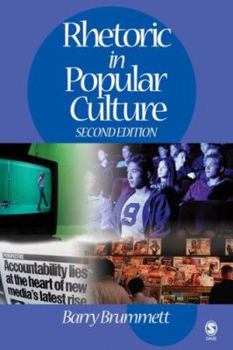Rhetoric in Popular Culture
Select Format
Select Condition 
Book Overview
Rhetoric in Popular Culture, Second Edition is the only textbook that uniquely joins together two vital scholarly traditions: rhetorical criticism and critical studies. Author Barry Brummett... This description may be from another edition of this product.
Format:Paperback
Language:English
ISBN:141291437X
ISBN13:9781412914376
Release Date:February 2006
Publisher:Sage Publications (CA)
Length:309 Pages
Weight:1.00 lbs.
Dimensions:0.7" x 6.0" x 9.0"
Customer Reviews
3 ratings
An Ace
Published by Thriftbooks.com User , 14 years ago
Rhetoric in Popular Culture does two things for me: it provides an easy link between stoic rhetoricians 21st century culture and offers great ideas for teaching rhetoric in undergrad classrooms. I came upon in accidentally and it's been wonderful. He doesn't leave anyone out --- Aristotle to Burke --- he covers traditional rhetoric and postmodern rhetoric.
Empowering students to use rhetoric to study popular culture
Published by Thriftbooks.com User , 22 years ago
Barry Brummett's "Rhetoric in Popular Culture" seeks to bring the traditions of rhetorical criticism and critical studies together. Brummett applies the growing and cutting-edge methods of critical studies to the study of rhetoric, because he sees critical studies AS rhetorical criticism. This is a premise with which I whole-heartedly agree, which is not surprising given my interest in rhetoric and social theory. Part I consists of four chapters dealing with theoretical and methodological concerns. The extended case study is on the film version of "The Wizard of Oz," in which Brummett looks at how five critical methods (Marxist, feminist/psychoanalytic, dramatistic/narrative, media-centered, and culture-centered) would render different interpretations of Dorothy's trip over the rainbow. Part II provides three critical studies: "Paradoxes of Personalization: Race Relations in Milwaukee," "Twin Peeks: Using Theory in Two Analyses of Visual Pleasures" (by Brummett and Margaret Carlisle Duncan) and "Afrocentrism and 'DO THE RIGHT THING'" (by Detine L. Bowers). Fortunately in this Postmodern world history is dead and most students are not aware of the rhetorical tradition that would disdain critical studies, not to mention popular culture. Consequently, Brummett does not have to convince students of the rightness of his cause, they are simply going to want to understand what he is talking about. Part I of this book is the stronger section, because Brummett's strength is in laying out his approach. Chapter 3, in which he looks at the key notion of "text," is the best one in the book. How you feel about Part II will come down to how relevant the specific case studies are to your students. Certainly "Do the Right Thing," despite its cultural importance once upon a time, would be considered "dated" by most students, although we might think it has again become relevant because of recent events. But Part I is basically two-thirds of the book, so I do not really think that this becomes a major consideration in deciding whether or not to use this book in class. Ultimately, the key consideration is going to be the sort of assignments you have the cherubs do off of the theories laid out in Part I. Brummet's point is that students should be empowered to "find the rhetoric in rap music, the motivations in heavy metal, and the arguments in argyle socks." That pretty much covers it all.
Good overview with examples
Published by Thriftbooks.com User , 23 years ago
This book provides a good overview of how to look at popular culture through a critical perspective. It has an interesting history section and also gives a brief explanation of various types of rhetorical criticism. It is an excellent supplemental text for any rhetoric class.





